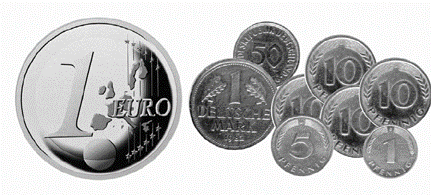
The United States of America has been a successful currency union for two centuries. Few people—historians, economists, or ordinary citizens—doubt that having a single currency, the dollar, contributed mightily to American prosperity and growth. Europe is now two years into a similarly ambitious currency union that is intended to further the prosperity and growth the continent has enjoyed since the Second World War. Europeans confident that the euro, which next Jan. 1 comes to life in the form of to-hand currency, can do the same, cite the American experience as precedent.
There are, however, a number of important differences between the two cases. Several are discussed below. Now that Europe has crossed the Rubicon to currency union, consciousness of these differences provides an agenda for the hard work that lies ahead for the European Monetary Union (EMU) and its members if the new regime is to live up to the hopes of its architects. Although many Union-wide institutions are already in place, other important institutions remain to be designed, negotiated, and built.
Philadelphia vs. Maastricht. The US Constitution, negotiated in the Philadelphia convention in 1787, came into force in 1789. It vested in the federal Congress the sole power “To coin Money, regulate the value thereof, and of foreign Coin.” The Constitution also established free trade, travel, and migration among the states, and required each state to give “full faith and credit” to the public acts of other states. There were only 13 states at the time; all the other 37 present members of the dollar currency union joined later as they advanced from territorial status to be admitted as states of the American union. As English colonies, the original states had not had their own moneys, and after jointly declaring independence in 1776 their weak Confederal government, the Continental Congress, had issued a weak paper currency without gold or silver backing. Both the Confederation and the member states themselves were heavily in debt at the end of the War of Independence. The new federal government established new dollars convertible into gold and silver, which made them indirectly convertible into pounds sterling, and assumed at face value all the debts of the Confederation and the states. This is not what is happening in Europe now. The Treaty of Maastricht is not the US Constitution.
Economic stabilization tools. Unexpected shocks to economic activity—demographic, technological, political, external—happen all the time. Some will hit all regions within the EU in the same way. Some will hit them in the same direction but with different force. Some will hit them in opposite ways. What tools will the Union and the member states have for moderating or reversing unwelcome business recessions or booms, or adapting to long-run changes in economic performance? How do these compare with the tools of economic policy before Maastricht and with those available in the US?
Currency valuations. The 11 members of the EMU are of course surrendering their freedom to change, or to allow markets to change, the values of their currencies with respect to each other and with respect to the dollar, yen and other currencies outside EMU. Members of the European Monetary System, effectively tied to the Deutsche mark, have mostly become accustomed to forgo this freedom, although several members did resort to devaluation as recently as 1992. At least one, the United Kingdom, seems to have prospered as a result. Anyway, this is not a freedom that American states have, so there will be no difference between continents in this respect.
Monetary policies. American states can have no monetary policies, and EMU member states will be in the same boat. How about monetary policies at the union levels? Here the powers of the EMU and the US Federal Reserve are comparable. However, the EMU charter directs the European Central Bank (ECB) to aim solely for price stability, presumably on average across its territory. This is not a big change from the de facto European monetary policy under Bundesbank management. The Federal Reserve has more discretion, and indeed is expected under current law to give weight to unemployment and to growth of real gross domestic product. Results since 1982 have been much better both on employment and GDP and on inflation than in Europe. The EMU directive could be particularly damaging to employment, production, and income in case of a big inflationary supply shock like the OPEC oil price increases of the 1970s. There is practically very little room for the ECB to differentiate the effects of its monetary policies among member states. This is true of the Federal Reserve, too.

CP Picture Archive
Fiscal policies, central government. The EU has no fisc, so it can’t have a fiscal policy, either for the Union as a whole or for member states differentially. Central revenues of the Union are not supposed to exceed 1.7 per cent of GDP, and expenditures are similarly limited. By comparison, the revenues of the US federal government are 21 per cent of GDP, expenditures likewise. Thus the US has considerable scope for fiscal policy, in several ways. Changes in federal government budget deficits or surpluses stimulate or restrict overall spending on goods and services. Expenditure and transfer programs can deliberately help particular states and regions suffering economic reverses. Help to states also comes as a byproduct of permanent federal programs. Fully 12 per cent of federal budget outlays are transfers of funds to state and local governments.
A more subtle but very important class of mechanisms are so-called “built-in stabilizers.” These are programs of federal transfers to state and local governments and to their citizens where the amounts transferred are determined by formulas measuring need—for example, more unemployment compensation when and where there is more unemployment; more federal help to education the poorer the local communities, more credit to local enterprises the weaker the local economy.
Fiscal policies, states. Continuing the Maastricht rule for admission to the union, the EMU rules forbid member states from running deficits larger than three per cent of their individual GDPs, under pain of a fine of 0.5 per cent of GDP. This rule applies whether the deficit arose because of economic recession outside the control of the member or because of fiscal profligacy. Moreover, the rule makes no distinction between current and capital expenditures.
In the US, by contrast, state budgets total 12 per cent of GDP and there are no federal restrictions on state budget policies. Most states are prohibited from running deficits on current account by their own constitutions, although deficits are allowed de facto in business cycle recessions. States are, however, free to finance capital expenditures, for example schools, highways, housing projects, and hospitals, by borrowing.
Market mechanisms of economic adjustment. Optimists about EMU think that they can get along without stabilization policies other than the ECB’s commitment to price stability. They would just rely on free markets to make the necessary adjustments to economic disturbances to the union as a whole or to member states. Prices and wages will, they trust, correct fluctuations in production and employment.
For this to happen, workers and capital must move between industries, occupations, locations, and states in response to market signals. They must go where the job and profit opportunities are, and prices and wages must register the right signals to induce them to do so. In the US, mobility of labor and capital is remarkably fast. Wages and prices are quite flexible, and both workers and business managers respond. Although immense changes in the composition of economic activity are constantly taking place— downsizing is terminating many jobs and plant closings and bankruptcies are always in the news—new jobs and new businesses keep the overall unemployment rate low and the aggregate profitability of business high.
Most of Europe, however, is suffering chronic double-digit unemployment, and accordingly Europe is producing far below capacity. European economists, bankers, and officials blame structural rigidities. Such rigidities are likely to make it difficult for market responses to handle the shocks that are bound to come.
In the best of circumstances, labor and capital will be much less mobile between member states of EMU than between American states. This is not surprising, given the United States’ two-century history of free trade and free movement across state lines, a common language; and also common or similar laws of contracts, property, bankruptcy; insurance, and professional practices and standards. Institutions of higher education are open to students from all locations and adhere to common academic standards. Social security and elderly health care are federal programs, and other safety nets are joint federal-state policies.
Europe is much less well equipped than the United States to adjust to inter-regional disturbances to economic activity both in the strength of forces of market adjustment and in the availability of governmental fiscal responses, automatic and discretionary.
Europe is also less well equipped to deal with worldwide or continental economic shocks than the United States, because of the absence of a federal government with possible fiscal responses, either automatic “built-in stabilizers” or discretionary policies. As to monetary policy, EMU is tying its own hands behind its back by forswearing any use of central bank powers to affect employment, production, and growth.
It may be that the challenge of adapting to an irreversible currency union will bring the farsighted building of institutions needed to make the experiment successful. For Europeans’ sake, let’s hope so.
Photo: Shutterstock







